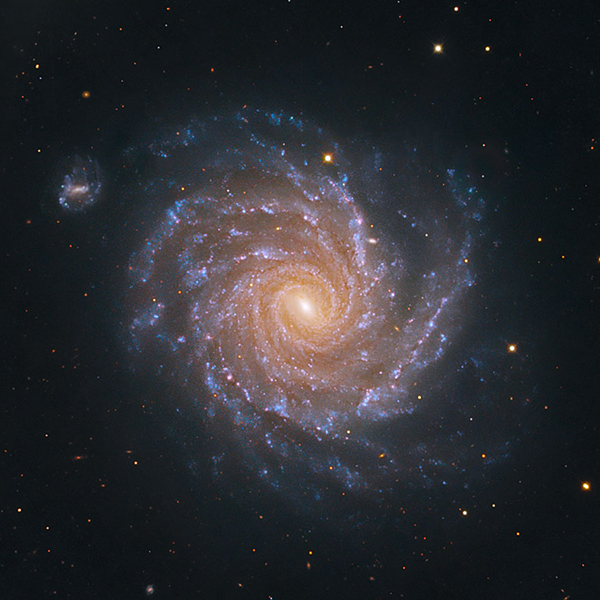 Treating gravity as the dominate force in the Universe and extragalactic redshifts as evidence of cosmic expansion creates a lot of unnecessary headaches for astrophysicists and cosmologists. A good example of this is an object posted in the gallery, galaxy 3C 348 and its radio loud core Hercules A. Mainstream scientists calculate that this galaxy’s spectral redshift of 0.155 z (z = (observed wavelength – rest wavelength)/(rest wavelength)) puts it at a distance of over 2 billion light years expanding away from us at almost 43,000 kilometers per second.
Treating gravity as the dominate force in the Universe and extragalactic redshifts as evidence of cosmic expansion creates a lot of unnecessary headaches for astrophysicists and cosmologists. A good example of this is an object posted in the gallery, galaxy 3C 348 and its radio loud core Hercules A. Mainstream scientists calculate that this galaxy’s spectral redshift of 0.155 z (z = (observed wavelength – rest wavelength)/(rest wavelength)) puts it at a distance of over 2 billion light years expanding away from us at almost 43,000 kilometers per second.
At first glance 3C 348 looks like just another ordinary elliptical galaxy and the radio jets of Hercules A appear typical of many other such jets that have been observed. But by placing them at such a huge cosmological distance scientists have created a monster. To account for this object’s angular size at such a great distance scientists have 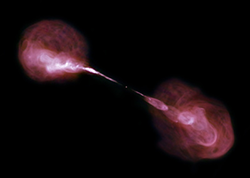 calculated that the galaxy is over a 1,000 times more massive than the Milky Way Galaxy and the jets streaming from the center of Hercules A are each almost a million light years long. They have also calculated that the central black hole powering these jets is nearly 1,000 times more massive than the black hole in the center of our galaxy or 3 to 4 billion times the mass of our sun. This makes it one of the largest black holes known.
calculated that the galaxy is over a 1,000 times more massive than the Milky Way Galaxy and the jets streaming from the center of Hercules A are each almost a million light years long. They have also calculated that the central black hole powering these jets is nearly 1,000 times more massive than the black hole in the center of our galaxy or 3 to 4 billion times the mass of our sun. This makes it one of the largest black holes known.
How do astrophysicists account for such a colossal object? The simple answer is they can’t. An object of this size just cannot be explained using any known physics or even hypothetical processes. But of course scientists only assume it’s so large because they also assume its redshift is a result of cosmic expansion. But there are other explanations for extragalactic redshifts, especially in a universe dominated by plasma and the electromagnetic force instead of gravity.
For example, Thomas Smid and Ari Brynjolfsson both have proposed intriguing and testable theories that light is redshifted when it passes through intergalactic plasma. It has even been suggested that Brynjolfsson’s theory has already been proven in the laboratory.  If true, plasma redshifts would completely change our current understanding of the universe. To quote Brynjolfsson from his website: “Plasma redshift explains the solar redshifts, the intrinsic redshifts of stars, quasars, the galactic corona, the cosmological redshifts, the cosmic microwave background, and the X-ray background. The plasma redshift explains the observed magnitude-redshift relation for supernovae SNe Ia without the big bang, dark matter, or dark energy. It explains also the observed surface brightness of galaxies. There is no cosmic time dilation. The universe is not expanding…..the universe is quasi-static, infinite, and everlasting. The universe can renew itself forever.”
If true, plasma redshifts would completely change our current understanding of the universe. To quote Brynjolfsson from his website: “Plasma redshift explains the solar redshifts, the intrinsic redshifts of stars, quasars, the galactic corona, the cosmological redshifts, the cosmic microwave background, and the X-ray background. The plasma redshift explains the observed magnitude-redshift relation for supernovae SNe Ia without the big bang, dark matter, or dark energy. It explains also the observed surface brightness of galaxies. There is no cosmic time dilation. The universe is not expanding…..the universe is quasi-static, infinite, and everlasting. The universe can renew itself forever.”
Images credit: NASA, ESA, S. Baum and C. O’Dea (RIT), R. Perley and W. Cotton (NRAO/AUI/NSF), and the Hubble Heritage Team (STScI/AURA)
NOTE: This object is also posted on the Plasma Pics online image gallery and discussion site.

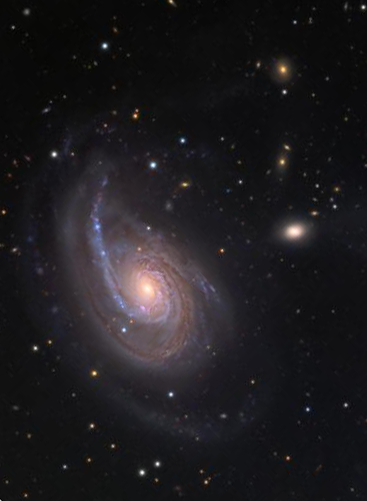
![NGC 772 and [HB89] 0156+187 NGC 772 and [HB89] 0156+187](http://discordancy.report/wp-content/uploads/2012/10/aladin_overlay_cropped_ngc772.png)
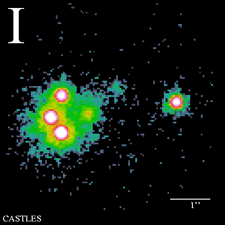
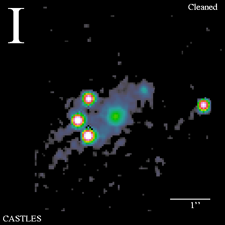
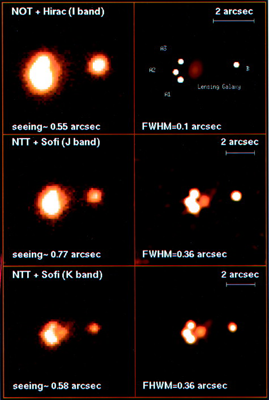 filtering software based on hypothetical gravitational lens models. Yet the image still clearly shows faint streamers of material between the central galaxy and encircling quasars, but they are not mirrored as would be expected in a gravitational lens. The near-infrared image on the right is from the 2.56 m
filtering software based on hypothetical gravitational lens models. Yet the image still clearly shows faint streamers of material between the central galaxy and encircling quasars, but they are not mirrored as would be expected in a gravitational lens. The near-infrared image on the right is from the 2.56 m 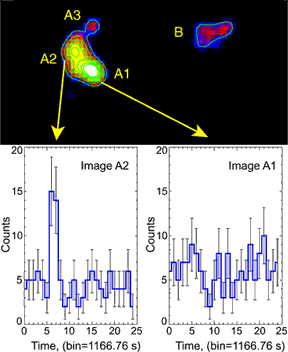 quasars must have occurred before their observations were made. The astronomers also claimed that a long term observation of this system will reveal shared flare ups among the quasar “mirages” providing precise extragalactic measurements and thereby allowing the expansion rate of the universe to be better estimated. The original observations were made back in 2000 and despite all of these claims there have still yet to be any long term observations made of RXJ0911+0551.
quasars must have occurred before their observations were made. The astronomers also claimed that a long term observation of this system will reveal shared flare ups among the quasar “mirages” providing precise extragalactic measurements and thereby allowing the expansion rate of the universe to be better estimated. The original observations were made back in 2000 and despite all of these claims there have still yet to be any long term observations made of RXJ0911+0551. The reason that quasars ejected from a central galaxy could be positioned in such a way is simplicity. A tetrahedron has the least number of faces and angles of any geometric solid. The least number of objects, other than a pair, that can be evenly spaced with matching angles around another centralized object is four, but only if they are positioned at the vertices of an imaginary orthographically projected tetrahedron.
The reason that quasars ejected from a central galaxy could be positioned in such a way is simplicity. A tetrahedron has the least number of faces and angles of any geometric solid. The least number of objects, other than a pair, that can be evenly spaced with matching angles around another centralized object is four, but only if they are positioned at the vertices of an imaginary orthographically projected tetrahedron.
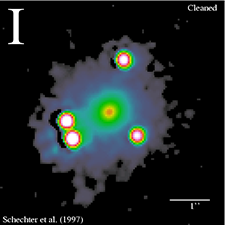
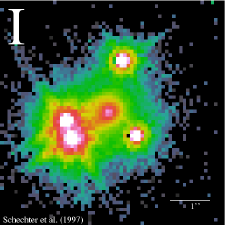 The following image on the left is from the CfA-Arizona Space Telescope LEns Survey (
The following image on the left is from the CfA-Arizona Space Telescope LEns Survey (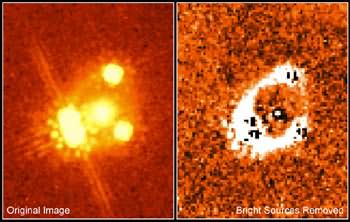 Despite this evidence there are still scientists who try to manipulate the data. The pair of infrared images on the left is taken from the Hubble Space Telescope NICMOS. The left image is the original while the right image has supposedly had the quasars and central galaxy digitally subtracted from it to reveal a lensed galaxy in the background. There are a few problems with this processed image however. Besides the dubious method of subtraction used to create the image, the resulting ring of light is incomplete and irregularly shaped and does not conform to any accepted
Despite this evidence there are still scientists who try to manipulate the data. The pair of infrared images on the left is taken from the Hubble Space Telescope NICMOS. The left image is the original while the right image has supposedly had the quasars and central galaxy digitally subtracted from it to reveal a lensed galaxy in the background. There are a few problems with this processed image however. Besides the dubious method of subtraction used to create the image, the resulting ring of light is incomplete and irregularly shaped and does not conform to any accepted 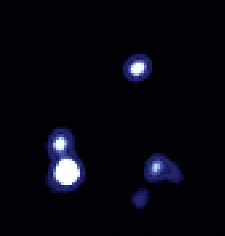 optical physics or gravitational lens models. The image to the right is a 7+ hour exposure of PG1115+080 made by the
optical physics or gravitational lens models. The image to the right is a 7+ hour exposure of PG1115+080 made by the  The best way to view these alignments is to utilize a Java applet such as
The best way to view these alignments is to utilize a Java applet such as 